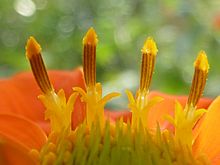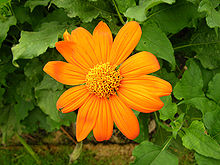Tithonia
| Tithonia | ||||||||||||
|---|---|---|---|---|---|---|---|---|---|---|---|---|

Mexican sunflower ( Tithonia diversifolia ) |
||||||||||||
| Systematics | ||||||||||||
|
||||||||||||
| Scientific name | ||||||||||||
| Tithonia | ||||||||||||
| Desf. ex Juss. |
The Tithonia Germanized, sometimes called Tithonien, are a genus in the subfamily of Asteroideae within the family of the daisy family (Asteraceae). The ten to eleven species are distributed from the southwestern United States through Mexico to Central America . The cultivars of a few species are used as ornamental plants and, regardless of which species they belong to, are called Mexican sunflowers .
description



Appearance and leaves
Tithonia TYPES grow as a year to perennial herbaceous plants , or if there are woody species form: subshrubs , shrubs and rare trees . Depending on the species, they usually reach heights of about 0.70 to 5, rarely up to 7 meters. The upright stems are mostly branched.
The leaves, which are often opposite in the upper area and otherwise mostly arranged alternately on the stems, are stalked or sessile. The leaf blade is simple with rarely one, usually three or five leaf veins already at or near the base of the blade . The leaf margin is smooth or sometimes three- to five-lobed. The leaf surfaces are smooth to differently hairy depending on the species.
Inflorescences, flowers and fruits
The long-stalked head-shaped inflorescences are single and terminal. The flower heads range in diameter from 1 to over 2 centimeters. In two to five rows are 12 to more than 28 bracts ; they are almost the same to very different in shape and size. The basket bottoms are hemispherical to convex. There are chaff leaves.
The flower heads contain eight to 30 ray-florets and mostly 40 to 120, rarely up to over 200 tubular florets. The asexual, sterile, zygomorphic ray- flowers (= ray-flowers) are yellow to orange in color (also red in cultivars). The hermaphroditic, fertile tubular flowers (= disc flowers) are usually yellow with five corolla lobes. The black, brown or straw-colored anthers have egg-shaped appendages. The two scar branches also have appendages.
The triangular, square or biconvex achenes are brown or black. The pappus is crown-shaped and consists of two more or less fused scales or it is absent.

Systematics and distribution
The natural range of the genus Tithonia extends from the southwest USA (three kinds) over Mexico (nine kinds) to Central America. Some species (especially Tithonia diversifolia ) are invasive plants in many areas of the world, such as the southeastern United States, the Caribbean islands, South America, and the Old World .
The genus Tithonia was first published in 1789 by René Desfontaines in Antoine-Laurent de Jussieu : Genera Plantarum , p. 189. Type species is Tithonia rotundifolia (Mill.) SFBlake . The botanical genus name Tithonia refers to Tithonos from Greek mythology, the son of Laomedon and the lover of Eos (whose Roman equivalent is Aurora , so Tithonia species are sometimes called the darling of the Aurora ). A synonym for Tithonia Desf. ex Juss. is Mirasolia (Sch.Bip.) Benth.
The genus Tithonia belongs to the subtribe Helianthinae from the tribe Heliantheae in the subfamily of Asteroideae within the sunflower family (Asteraceae).
There are ten to eleven species in the genus Tithonia :
- Tithonia brachypappa B.L.Rob. : It occurs only in the two Mexican states of Tamaulipas and San Luis Potosí .
- Tithonia calva Sch.Bip. : The three varieties are common in the Mexican states of Chihuahua , Durango , Sinaloa , southern Sonora , Jalisco and Nayarit .
- Mexican sunflower ( Tithonia diversifolia (Hemsl.) Gray ): The natural range extends from the tropical Mexican states of Sinaloa, Campeche , Chiapas , Guerrero , Michoacán , Oaxaca , Quintana Roo , Tabasco , Veracruz and Yucatán and in Central America from Guatemala and Belize via Costa Rica , El Salvador , Honduras , Nicaragua to Panama ; it is thus the most widespread Tithonia species. It is an invasive plant in many parts of the world . Their common name in Cuba due to their use is "Margaritoneladasa" or "Arnica de la Tierra". In Colombia it is called “Mirasol” or “Botón de Oro” because of its colors.
- Tithonia fruticosa S.Canby & Rose : It thrives in canyons and on slopes, mostly near water, in the Mexican states of Chihuahua, Sinaloa, Sonora and Durango.
- Tithonia hondurensis La Duke : It is distributed from Belize to Honduras.
- Tithonia koelzii McVaugh : This small tree is only known from the type location in the Mexican state of Jalisco.
- Tithonia longiradiata (Bertol.) SFBlake (Syn .: Tithonia scaberrima Benth. , Tithonia platylepis Sch.-Bip. , Tithonia pittieri (Greenm.) SFBlake ): It thrives in arid areas from east-central Mexico to Panama.
- Tithonia pedunculata Cronquist : This Mexican endemic occurs only in dry locations in central Oaxaca.
- Torch flower, Mexican sunflower or round-leaved tithonia ( Tithonia rotundifolia (Mill.) SFBlake , Syn .: Tithonia speciosa (Hook.) Griseb. , Tithonia speciosa Hook. , Tithonia speciosa (Hook.) Klatt , Tithonia aristata Oersted , Tithonia uniflora Desf. Ex JFGmel. ): The natural range extends from the central and southern Mexican states of Coahuila, Durango, Zacatecas , Campeche, Chiapas, Colima , Guerrero, Hidalgo, Jalisco, México , Morelos , Nayarit , Oaxaca, Quintana Roo, Veracruz and Central America from Guatemala and Belize via Costa Rica, El Salvador , Honduras, Nicaragua to Panama. As an ornamental plant, it is usually cultivated as an annual plant. Its common Spanish name is "clavel de muerto" - roughly translated as "Carnation of the Dead". It is an invasive plant in many parts of the world.
- Tithonia thurberi A.Gray (Syn .: Tithonia palmeri Rose ): It thrives in ruderal places , in canyons and in rivers at altitudes of 900 to 1000 meters in Arizona and in the northern part of the Mexican state of Sonora .
- Tithonia tubaeformis (Jacq.) Cass. : It is common in large parts of tropical Mexico and in Central America as far as Panama.
Here are some species that used to belong to the genus Tithonia , belong to the genus Enceliopsis or Viguiera , for example:
- Tithonia argophylla D.C.Eaton ⇒ Enceliopsis argophylla (DCEaton) A.Nelson
- Tithonia pachycephala DC. ⇒ Viguiera pachycephala (DC.) Hemsl.
swell
- John C. La Duke: Tithonia. In: Flora of North America Editorial Committee (Ed.): Flora of North America North of Mexico . Volume 21: Magnoliophyta: Asteridae, part 8: Asteraceae, part 3 (Heliantheae, Eupatorieae). Oxford University Press, New York / Oxford a. a. 2006, ISBN 0-19-530565-5 , pp. 138 (English). , online.
- John C. La Duke: Revision of Tithonia. In: Rhodora. Volume 84, No. 840, 1982, pp. 453-522, scanned at biodiversitylibrary.org .
- Eduardo Morales: Estimating phylogenetic inertia in Tithonia (Asteraceae): A comparative approach. In: evolution. Volume 54, No. 2, 2000, pp. 475-484, DOI: 10.1111 / j.0014-3820.2000.tb00050.x .
Individual evidence
- ↑ a b c John C. La Duke: Tithonia. In: Flora of North America Editorial Committee (Ed.): Flora of North America North of Mexico . Volume 21: Magnoliophyta: Asteridae, part 8: Asteraceae, part 3 (Heliantheae, Eupatorieae). Oxford University Press, New York / Oxford a. a. 2006, ISBN 0-19-530565-5 , pp. 138 (English). , online.
- ↑ Desf. ex Juss. Scanned in 1789 at biodiversitylibrary.org .
- ↑ a b c d e f g h i j k l m n o p John C. La Duke: Revision of Tithonia. In: Rhodora. Volume 84, No. 840, 1982, pp. 453-522, scanned at biodiversitylibrary.org .
- ↑ Lotte Burkhardt: Directory of eponymous plant names . Extended Edition. Botanic Garden and Botanical Museum Berlin, Free University Berlin Berlin 2018. online.
- ↑ a b c d e f Tithonia in the Germplasm Resources Information Network (GRIN), USDA , ARS , National Genetic Resources Program. National Germplasm Resources Laboratory, Beltsville, Maryland.
- ↑ Clara Inés Ríos Katto, Amparo Salazar: Botón de oro (Tithonia diversifolia (Hemsl.) Gray) una fuente proteica alternativa para el trópico. In: Livestock Research for Rural Development. Volume 6, No. 3, 1995. CIPAV. ISSN 0121-3784 , online.
Web links
- Entry in the Flora of Zimbabwe . (engl.)



